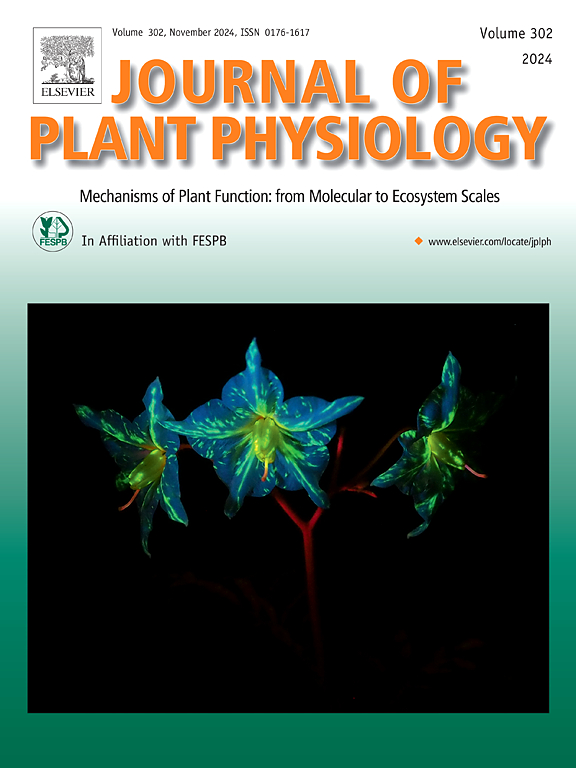Ionome profiling discriminate genotype-dependent responses to drought in durum wheat
IF 4.1
3区 生物学
Q1 PLANT SCIENCES
引用次数: 0
Abstract
Low-resource environments, such as dry or infertile soils, result in limited plant growth and development, which in turn constrain crop productivity. Water shortage is a significant threat to agricultural productivity all over the world. Drought may also affect plant nutrient uptake and assimilation capability causing nutrient deficiencies even in fertilized fields. Durum wheat is an important staple food crop for ensuring food security in the Mediterranean area, which is increasingly subjected to periods of severe drought due to global changes. Thus, identifying wheat cultivars/genotypes able to cope with suboptimal water, and with unbalanced nutrient availability deriving from drought is crucial to mitigate climate change's adverse effects on agriculture.
In this study, a detailed analysis of the phenome, including biomass production, proline production, and characterization of root system architecture, and the ionome, was performed on a panel of 15 Triticum turgidum genotypes, differing for drought tolerance, in order to understand the genotype-specific physiological responses to drought and to identify those genotypes characterised by a positive correlation between ion homeostasis and drought response. The characterization of root system architecture helped our understanding of the morphological responses of wheat plants to drought. Our findings demonstrated that drought exposure for 7 days significantly impacted the ionomic profiles of most genotypes in both shoot and root tissues, albeit to varying degrees. The Lcye A−B- genotype showed the highest accumulation efficiency for most nutrients in shoots, while Bulel tritordeum and Karim in roots. It is also important to understand how micronutrients interact with each other and with macronutrients. Thus, we performed a nutrient correlation network analysis, which showed that drought altered the interactions between nutrients in most genotypes. These findings underscore the importance of understanding the mechanisms regulating nutrient homeostasis, as these mechanisms can either mitigate or exacerbate the impact of drought stress.
Understanding the interplay between ionomic profiles and environmental conditions can provide valuable insights into developing more resilient crops that can thrive in challenging environments, ultimately contributing to global food security in the face of climate change.
离子组基因分析区分硬粒小麦对干旱的基因型依赖性反应
干旱或贫瘠的土壤等低资源环境限制了植物的生长和发育,进而制约了作物的产量。缺水是对全世界农业生产力的重大威胁。干旱还可能影响植物对养分的吸收和同化能力,即使在施肥的田地里也会造成养分缺乏。硬质小麦是确保地中海地区粮食安全的重要主食作物,由于全球变化,该地区遭受严重干旱的时期日益增多。因此,确定能够应对次优水量和干旱造成的养分供应不平衡的小麦栽培品种/基因型,对于减轻气候变化对农业的不利影响至关重要。在这项研究中,我们对 15 个耐旱性不同的小麦基因型进行了表型组(包括生物量产量、脯氨酸产量、根系结构表征)和离子组的详细分析,以了解基因型对干旱的特异性生理反应,并确定离子平衡与干旱反应之间具有正相关性的基因型。根系结构的表征有助于我们了解小麦植株对干旱的形态反应。我们的研究结果表明,尽管程度不同,但持续 7 天的干旱对大多数基因型的嫩枝和根部组织的离子群特征都有显著影响。Lcye A-B- 基因型在芽中对大多数养分的积累效率最高,而 Bulel tritordeum 和 Karim 在根中的积累效率最高。了解微量营养元素之间以及与宏量营养元素之间的相互作用也很重要。因此,我们进行了养分相关网络分析,结果表明干旱改变了大多数基因型中养分之间的相互作用。这些发现强调了了解养分平衡调节机制的重要性,因为这些机制可以减轻或加剧干旱胁迫的影响。了解离子组学特征与环境条件之间的相互作用,可以为开发在具有挑战性的环境中茁壮成长的抗逆性更强的作物提供有价值的见解,最终在气候变化的情况下促进全球粮食安全。
本文章由计算机程序翻译,如有差异,请以英文原文为准。
求助全文
约1分钟内获得全文
求助全文
来源期刊

Journal of plant physiology
生物-植物科学
CiteScore
7.20
自引率
4.70%
发文量
196
审稿时长
32 days
期刊介绍:
The Journal of Plant Physiology is a broad-spectrum journal that welcomes high-quality submissions in all major areas of plant physiology, including plant biochemistry, functional biotechnology, computational and synthetic plant biology, growth and development, photosynthesis and respiration, transport and translocation, plant-microbe interactions, biotic and abiotic stress. Studies are welcome at all levels of integration ranging from molecules and cells to organisms and their environments and are expected to use state-of-the-art methodologies. Pure gene expression studies are not within the focus of our journal. To be considered for publication, papers must significantly contribute to the mechanistic understanding of physiological processes, and not be merely descriptive, or confirmatory of previous results. We encourage the submission of papers that explore the physiology of non-model as well as accepted model species and those that bridge basic and applied research. For instance, studies on agricultural plants that show new physiological mechanisms to improve agricultural efficiency are welcome. Studies performed under uncontrolled situations (e.g. field conditions) not providing mechanistic insight will not be considered for publication.
The Journal of Plant Physiology publishes several types of articles: Original Research Articles, Reviews, Perspectives Articles, and Short Communications. Reviews and Perspectives will be solicited by the Editors; unsolicited reviews are also welcome but only from authors with a strong track record in the field of the review. Original research papers comprise the majority of published contributions.
 求助内容:
求助内容: 应助结果提醒方式:
应助结果提醒方式:


